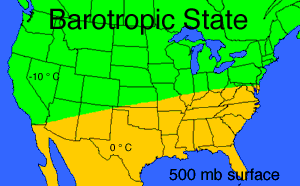 Imagine you are flying on a level of constant pressure. The plane can only fly where the pressure is the same as what it is now. The plane will be able to travel great distances horizontally, but will only change its altitude slightly. Constant pressure surfaces correspond closely to constant height surfaces, but not exactly, so the plane is traveling on an isobaric surface. Now imagine that the temperature everywhere on that isobaric surface is the same. This is called a barotropic state. Barotropic situations are common over the southeastern U.S. during the summer time when high pressure controls the weather patterns for extended periods of time. You can remember that a barotropic state is typical of tropical regions.
Imagine you are flying on a level of constant pressure. The plane can only fly where the pressure is the same as what it is now. The plane will be able to travel great distances horizontally, but will only change its altitude slightly. Constant pressure surfaces correspond closely to constant height surfaces, but not exactly, so the plane is traveling on an isobaric surface. Now imagine that the temperature everywhere on that isobaric surface is the same. This is called a barotropic state. Barotropic situations are common over the southeastern U.S. during the summer time when high pressure controls the weather patterns for extended periods of time. You can remember that a barotropic state is typical of tropical regions.
Barotropic atmospheres are relatively unchanging with time, and are, therefore, easy to model. Models that use a barotropic atmosphere as conditions for the model are called barotropic models. A barotropic model assumes that the temperature along a pressure surface is constant. Barotropic models are more simplistic than baroclinic models.
 A baroclinic atmosphere is one which has a large temperature change along an isobaric surface. Some examples of baroclinic atmopheres are frontal zones, and areas of large temperature gradients.
A baroclinic atmosphere is one which has a large temperature change along an isobaric surface. Some examples of baroclinic atmopheres are frontal zones, and areas of large temperature gradients.
A baroclinic model is more complex than a barotropic model because it must account for the change in temperature over the pressure surface. Of course, a baroclinic model is also more accurate for areas of large temperature changes. When looking at types of models used for different situations, modelers look at the temperature structure of isobaric surfaces to determine whether a barotropic or a baroclinic model is most appropriate.
 The Shodor
Education Foundation, Inc.
The Shodor
Education Foundation, Inc.